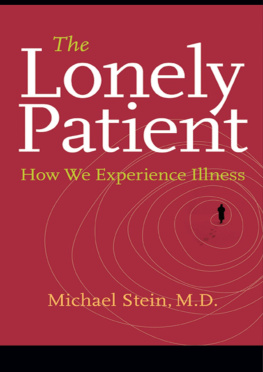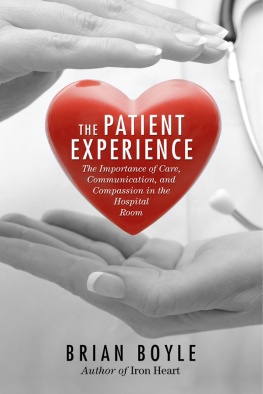Michael Stein - The Lonely Patient
Here you can read online Michael Stein - The Lonely Patient full text of the book (entire story) in english for free. Download pdf and epub, get meaning, cover and reviews about this ebook. year: 2008, publisher: Harper Collins, genre: Art. Description of the work, (preface) as well as reviews are available. Best literature library LitArk.com created for fans of good reading and offers a wide selection of genres:
Romance novel
Science fiction
Adventure
Detective
Science
History
Home and family
Prose
Art
Politics
Computer
Non-fiction
Religion
Business
Children
Humor
Choose a favorite category and find really read worthwhile books. Enjoy immersion in the world of imagination, feel the emotions of the characters or learn something new for yourself, make an fascinating discovery.
- Book:The Lonely Patient
- Author:
- Publisher:Harper Collins
- Genre:
- Year:2008
- Rating:4 / 5
- Favourites:Add to favourites
- Your mark:
- 80
- 1
- 2
- 3
- 4
- 5
The Lonely Patient: summary, description and annotation
We offer to read an annotation, description, summary or preface (depends on what the author of the book "The Lonely Patient" wrote himself). If you haven't found the necessary information about the book — write in the comments, we will try to find it.
The Lonely Patient — read online for free the complete book (whole text) full work
Below is the text of the book, divided by pages. System saving the place of the last page read, allows you to conveniently read the book "The Lonely Patient" online for free, without having to search again every time where you left off. Put a bookmark, and you can go to the page where you finished reading at any time.
Font size:
Interval:
Bookmark:
For Nancy,
Anna,
Oliver,
and,
of course,
Richard
My depiction of Richard here is true to the best of my recollection. In the patient stories, I have changed names and specific circumstances so as to protect each individuals anonymity and the privacy of their families.
My brother-in-law Richard was a sculptor. For almost a year, he had been having vague symptoms, bloody noses and spots of numbness on the roof of his mouth, which he blamed on mold in his studio, the vagaries of New England weather, and a lifetime of exposure to epoxy-laden materials. In late March, we shared our weekly midday meal at Johnnies Luncheonette. We each ordered the usual. For Richard, it was onion rings, which left his lips shiny, and a chocolate shake. I had a turkey sandwich, mashed potatoes, and water with a slice of lemon. As we skidded home in the snow, Richard told me that he had a rare form of sinus cancer. He looked no different than he had the week before: wild-haired and thick-nosed at fifty, an expressive face with deep lines slanting from his nostrils to the corners of his mouth. His hands, gripping the steering wheel, were large and knotty. His size had intimidated me as a boy; now as then, his dramatic voice was overshadowed by his yet bigger ideas about almost everything.
I had always thought of Richard as invincible, so at first I didnt believe hed understood correctly what hed been told. Then I realized he had just told me the impossible truth. He seemed to have no more to say about it, and I had a sudden, panicky feeling that he was waiting for me to say something medical, to give him advice. But I was speechless, trying to collect what I knew about patients, cancer, the pervasive possibility of death, the experience of illness, and all the comforting things Id told the strangers I had cared for in the five years since completing my medical training. I was a young doctor then and didnt know what to say. I didnt want him to die. I wanted to reassure my brother-in-law, offer him uncomplicated hope, as well as quell my already rising sorrow.
At the time, I was a general internist practicing at an inner-city academic hospital, treating patients with AIDS and heart disease, colds, asthma, and chronic pain. I saw some of these patients in their homes; some in my dingy, green-carpeted, yellow-aired clinic; and some on the overcrowded hospital wards. During these early years of practice, I had, perhaps, concentrated too much on how people become ill and how their problems can be fixed, without trying to imagine what its like to be ill. Whether out of self-pity or self-negligence, or because I was caring for too many patients in too little time, or because of the daily difficulty of seeing pain and terror, already I was no longer attempting to understand what my patients were communicating in gesture and expression, what was unsaid: why they were unhappy, what was bothering them most, how their bodies and lives had changed since they became sick.
Doctors feel obliged to strike the right emotional balance with patients: not too harsh, not too pitying. We are trained to hear and give grim news. From the first days of anatomy lab, we are inclined, even taught, to shut down. Rather than disclosing too much about ourselvesour judgments and contempt, our moods and fearwe are expected to keep our distance from patients. We deny that this distancing is a choice. Presented as a necessary rule, a requirement of composure, this self-protection disappoints patients interested in the interior world of their illness, the emotional life thats not on show. As doctors, we cant help being moved by the heartbreak of the individual medical moment, yet we never forget that patients are also examples of minutely studied biological processes. We refuse to be either impressed or surprised as we apply Joseph Brodskys suggestion: Keep eyes wide open, not so much in wonderment, or poised for revelation as in look-out for danger.
Early in my career, with the repetition of seeing twenty patients a day in a small exam room, I became like one of my ill patients: I had entered a world of black and white, a world without nuance, with only a two-word languagesick and well. Gone were subtle gradations of color and dialect that an artist would appreciate. Then Richard got sick, and in the car that day I longed for a rich, fully formed vocabulary with which to speak to him about his illness and to help me understand it. I didnt have one.
The challenges of communication were well known to me. I had published two novels, been nominated for awards, and even taken up the subject of medicine in my second book. Richard bragged to everyone that it was the best book ever written about doctors, even though he had never read it. Still, before that drive from Johnnies Luncheonette, I had never fully applied myself to the notion of illness, to traveling mindfully across its terrain. I was on automatic, doing my work with the cool precision of debridement. I spoke the language of medicine fluently but hadnt tried very hard to learn the idiom of the ill. I always thought that a doctor in good health could never quite appreciate illness. Each patients emotions seemed just slightly out of my reach. I was inarticulate about the patients experience of illness, but I was also holding back, in part because of my training and in part because I believed that I didnt have the right to ask or intrude.
My formal training in talking with patients took place at the end of the second year of medical school when I finally put my textbooks aside and began the requisite course on medical interviewing. Clinical information-gathering, I learned, has its own stiff anatomy and orderchief complaint, history of present illness, past medical history, review of symptoms. I memorized the list of topics to be covered when speaking with a new patient and watched my supervisor, a senior doctor, perform a series of interviews. Finally, the day arrived. My teacher escorted me to the bedside of an elderly woman with heart failure and sat in a chair behind me. Glancing down at my notes so as not to forget any important details, I spoke with this patient. Caught up in the excitement of my first encounter, trying hard to keep moving through my list of questions and at the same time to write down her responses, I sometimes neglected to talk slowly or to nod in sympathy, simple human behaviors that, I was to learn, patients depend on.
For years after this course, my interviewing style remained close to what I had practiced as a student. Only as my experience with patients increased did I begin to understand that trying to make a patient feel better sometimes only makes him feel worse. Intent on teaching me the basics in four weeks, my teacher and I never had the opportunity to discuss how difficult it is to use humor to disarm a patient, or how to foster an ill persons determination, or how to make a patient believe he still rules his own body.
Illness arrives, literally, out of nowhere. Newly ill, the patient immediately recalls the sick days of childhood, the afternoons asleep and the midnights awake, the disturbance of the natural daily rhythm. As an adult, illness makes him feel out of place, unaccountably absent, far outside existence. The patient expects illness to enforce a sense of restlessness and fluidity, but groggy and passive, he soon feels taken over, trapped, imprisoned. The patient expects to be dependent on others, but not the humiliation and indignity this sometimes brings. After a very short time, the patient wants to pretend hes well, to look the other way rather than face the new reality that the body can be hurt, attacked, scarred, that he and his body can fail.
Patients cannot put into words the extravagant difference between how they once imagined they would handle illness and how they actually do once it is upon them. Illness is repressive. The ill person forces himself to feel calm, to silence the high keening of distress. He is determined to keep his turmoil dormant. There is a palpable denial of emotion as the patient resists feeling anything but bewilderment. Yet emotions creep up and first emerge in the small clearings of idle time, and when they do, patients have difficulty identifying and describing these new and uncomfortable emotional states that have arrived with illness. The patient holds back, despite an urge for self-expression, because he doesnt want to complain and he doesnt want to worry himself; being completely candid makes him vulnerable.
Font size:
Interval:
Bookmark:
Similar books «The Lonely Patient»
Look at similar books to The Lonely Patient. We have selected literature similar in name and meaning in the hope of providing readers with more options to find new, interesting, not yet read works.
Discussion, reviews of the book The Lonely Patient and just readers' own opinions. Leave your comments, write what you think about the work, its meaning or the main characters. Specify what exactly you liked and what you didn't like, and why you think so.











